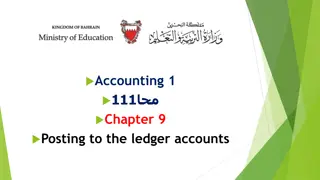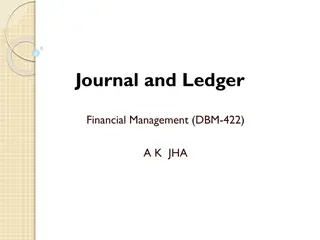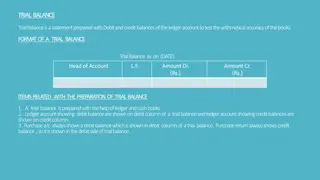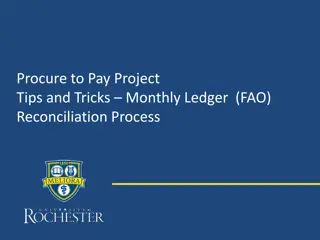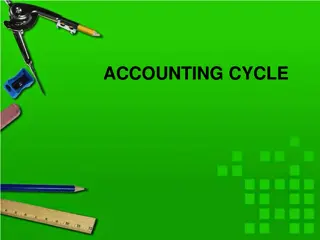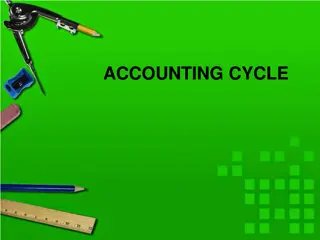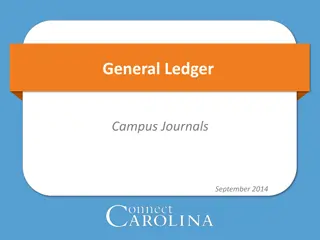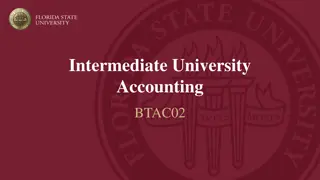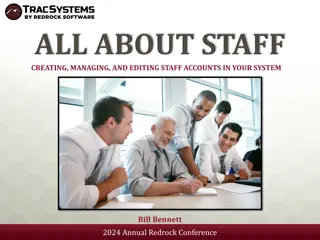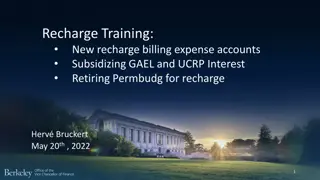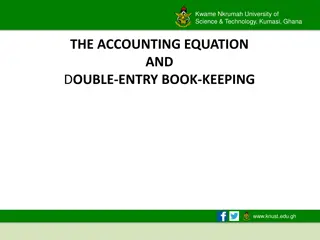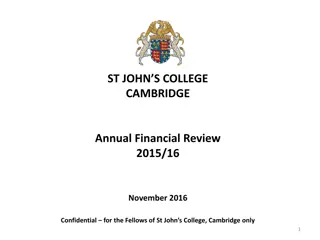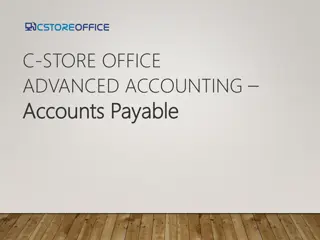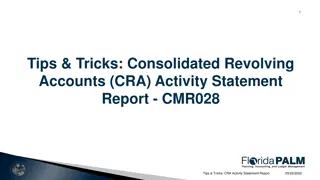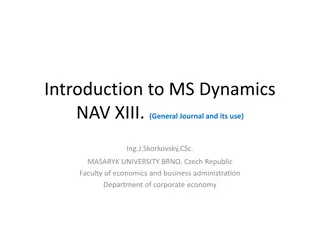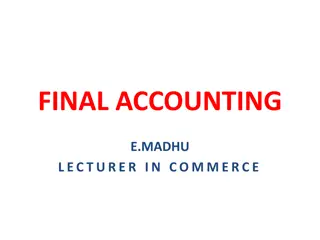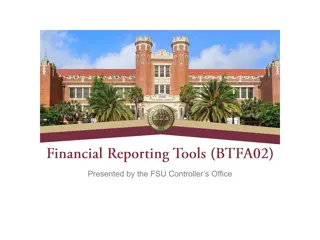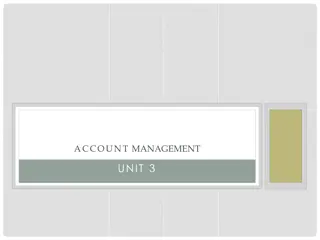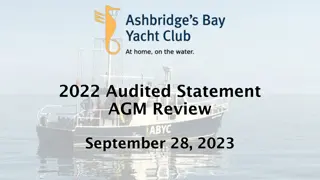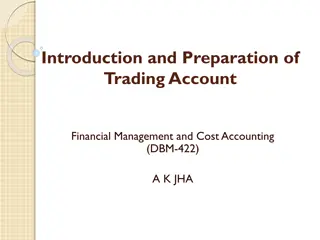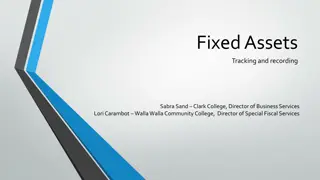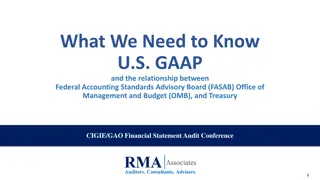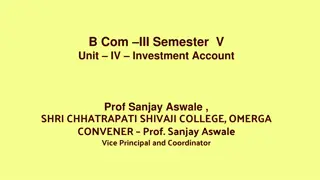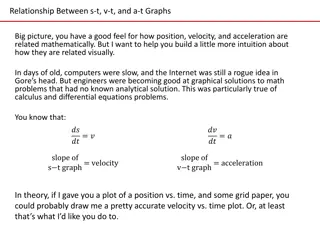Understanding Ledger Accounts and Financial Position
Ledger accounts play a crucial role in recording individual item changes affecting financial position. Each balance sheet item has its own account, ensuring accurate financial tracking. The accounting equation dictates where assets, liabilities, and owner's equity are located on the balance sheet, with the ledger providing important balance values. Maintaining a proper ledger is essential for preparing accurate financial statements and understanding the overall financial health of a business.
Download Presentation

Please find below an Image/Link to download the presentation.
The content on the website is provided AS IS for your information and personal use only. It may not be sold, licensed, or shared on other websites without obtaining consent from the author. Download presentation by click this link. If you encounter any issues during the download, it is possible that the publisher has removed the file from their server.
E N D
Presentation Transcript
Chapter 4: THE SIMPLE LEDGER 1
LEDGER ACCOUNTS 2
Colin My first teaching contract was a classic dog s breakfast that included teaching seven different preps, including one period where three (very different) courses were put together in the same room, at the same time. (Not just a split class, a split/split/split class!) I m focused on maintaining a work/life balance while still giving my students the time and attention that they need to be successful. 3
LEDGER ACCOUNTS An account is a page specially designed to record the changes in each individual item affecting the financial position. A ledger is a group or file of accounts A ledger can take many forms: cards, paper in binders, electronic files, etc. 4
LEDGER ACCOUNTS Each individual balance sheet item is given its own account.Typically, you would have one account per page. The dollar figure for each balance sheet item is recorded in the account on the first line. This is the beginning balance for the account. 5
LEDGER ACCOUNTS Ensure that you record the dollar figure on the correct side of the account. The ledger and the balance sheet both show financial position if you have a ledger you can prepare a balance sheet if you have a balance sheet you can prepare a ledger. 6
THE ACCOUNT Three parts: 1. Title 2. left side 3. right side In its simplest form, these parts are positioned like the letter T Therefore called a T Account
LEDGER ACCOUNTS What is the accounting equation? Which side of the balance sheet do you find assets? Liabilities? Owner s Equity? Where would you normally find the ledger balance for assets? Liabilities? Owner s Equity? = + Assets Liabilities Owner s Equity Beginning $ Value Beginning $ Value Beginning $ Value Left Right Left Right Left Right 8
Assets = Liabilities + Owners Equity B. Rissien, Capital Cash 3,265 Supplies 2,465 Bank Loan 18,000 60,287 A/R W. Caruso 150 A/P Dini Bros. Trucks 55,075 1,516 A/R R. Van Loon 620 A/P Packham Products Equipment 22,174 3,946 10
EXERCISE 1 (PAGE 91) Set up the ledger for Stevens Woodworking using T-accounts. 11
EXERCISE 3 (PAGE 92) Shown below is the ledger of Lilly Wall, who operates an interior design business. Create a balance sheet as of January 31, 2008. Accounts Receivable 2,100 Cash 500 Supplies 1,500 Equipment 2,800 Accounts Payable Lilly Wall, Capital Bank Loan 950 2,000 ??? 12
HOMEWORK Section 4.1 Review Questions 1, 2 Section 4.1 Exercises 1, 2, 3,4 13
DEBIT & CREDIT THEORY 14
LEDGER ACCOUNTS Earlier we learned that ledger accounts have a left side and a right side . Accountants refer to these two sides as Debit and Credit. Liabilities Left Right Assets Left Right Owner s Equity Left Right = + Debit Credit (DR) (CR) Debit Credit (DR) (CR) Debit Credit (DR) (CR) For ALL ACCOUNT, the left side is the Debit side and the right side is the Credit side. 15
THE T ACCOUNT 1. Title 3. Credit 2. Debit
DEBITS & CREDITS Debit (Dr.) indicates left; Credit (Cr.) indicates right Entering an amount on the left side is called debiting the account Entering an amount on the right side is crediting the account Debit balance Debits > Credits Credit balance Credits > Debits
THE T ACCOUNT 1. Title 3. Credit (right side) 2. Debit (left side) Debit balance Credit balance
RULES OF DEBIT AND CREDIT Now that we know which side of the account is debit and which is credit, we need to know how to enter changes in the accounts. The rule feeds from the normal beginning balance what are they? Does a debit or a credit increase or decrease the balance in the account? Liabilities Debit Credit (DR) (CR) Assets Debit Credit (DR) (CR) Beginning $ Value Owner s Equity Debit Credit (DR) (CR) = + Beginning $ Value Beginning $ Value 20
TRANSACTION ANALYSIS SHEET FOR PACIFIC TRUCKING The company purchases $200 worth of supplies from Packham Products, to be paid for later. ++ Supplies A/P Packham Products Asset DR CR 200 200 Liabilities An accountant would express this transaction as: debit Supplies and credit AP Packham Products, $200. 21
PACIFIC TRUCKING LEDGER B. Rissien, Capital Cash 3,265 Supplies 2,465 200 Bank Loan 18,000 60,287 A/R W. Caruso 150 A/P Dini Bros. Trucks 55,075 1,516 A/R R. Van Loon 620 A/P Packham Products Equipment 22,174 3,946 200 22
TRANSACTION ANALYSIS SHEET FOR PACIFIC TRUCKING The company pays $500 to Dini Bros. In partial payment of the amount owed to them. A/P Dini Bros. Cash Liability DR CR 500 500 Asset An accountant would express this transaction as: debit A/P Dini Bros and credit Cash, $500. 23
PACIFIC TRUCKING LEDGER Cash Supplies 3,265 2,465 200 B. Rissien, Capital Bank Loan 500 18,000 60,287 A/R W. Caruso 150 A/P Dini Bros. 500 Trucks 55,075 1,516 A/R R. Van Loon 620 A/P Packham Products Equipment 22,174 3,946 200 24
TRANSACTION ANALYSIS SHEET FOR PACIFIC TRUCKING The company receives $200 cash from R. Van Loon in partial payment of her debt. + Cash Asset DR 200 200 A/R R. Van Loon Asset CR An accountant would express this transaction as: debit Cash and credit A/R R. Van Loon, $200. 25
PACIFIC TRUCKING LEDGER Cash Supplies 3,265 2,465 200 200 B. Rissien, Capital Bank Loan 500 18,000 60,287 A/R W. Caruso 150 A/P Dini Bros. 500 Trucks 55,075 1,516 A/R R. Van Loon 620 A/P Packham Products Equipment 22,174 200 3,946 200 26
TRANSACTION ANALYSIS SHEET FOR PACIFIC TRUCKING A delivery service is provided for a customer at a price of $400. The customer pays cash at the time of the service. + Cash Asset DR 400 + 400 B. Rissien, Capital Owner s Equity CR An accountant would express this transaction as: debit Cash and credit B. Rissien, Capital, $400. 27
PACIFIC TRUCKING LEDGER B. Rissien, Capital Cash 3,265 200 400 Supplies 2,465 200 Bank Loan 500 18,000 60,287 400 A/R W. Caruso 150 A/P Dini Bros. 500 Trucks 55,075 1,516 A/R R. Van Loon 620 A/P Packham Products Equipment 22,174 200 3,946 200 28
TRANSACTION ANALYSIS SHEET FOR PACIFIC TRUCKING A used truck costing $8,000 is purchased from Dini Bros. A cash down payment of $2,500 is made at the time of the purchase and the balance is to be paid at a later date. + Truck Asset DR 8,000 + 2,500 5,500 Cash A/P Dini Bros Asset Liability CR CR An accountant would express this transaction as: debit Trucks $8,000, credit Cash $2,500 and credit A/P Dini Bros $5,500. 29
PACIFIC TRUCKING LEDGER B. Rissien, Capital Cash 3,265 200 400 Supplies 2,465 200 Bank Loan Notice: total Debits still EQUAL total Credits 500 2,500 18,000 60,287 400 A/R W. Caruso 150 A/P Dini Bros. 500 Trucks 55,075 8,000 1,516 5,500 A/R R. Van Loon 620 A/P Packham Products Equipment 22,174 200 3,946 200 30
TRANSACTION ANALYSIS SHEET FOR PACIFIC TRUCKING A delivery service is completed for R. Van Loon at a price of $350. Van Loon does not pay for the service at the time it is provided, but agrees so pay within 60 days. + A/R R. Van Loon Asset DR 350 + 350 B. Rissien, Capital Owner s Equity CR An accountant would express this transaction as: debit A/R R. Van Loon and credit B. Rissien, Capital, $350. 31
PACIFIC TRUCKING LEDGER Cash Supplies 3,265 2,465 200 200 400 B. Rissien, Capital Bank Loan 500 2,500 18,000 60,287 400 350 A/R W. Caruso 150 A/P Dini Bros. 500 Trucks 55,075 8,000 1,516 5,500 A/R R. Van Loon 620 350 A/P Packham Products Equipment 22,174 200 3,946 200 32
TRANSACTION ANALYSIS SHEET FOR PACIFIC TRUCKING One of the lifting machines (equipment) breaks down. The company spends $650 cash to have the machine repaired. B. Rissien, Capital Owner s Equity DR 650 650 Cash Asset CR An accountant would express this transaction as: B. Rissien, Capital and credit Cash, $650. 33
PACIFIC TRUCKING LEDGER B. Rissien, Capital 650 Cash 3,265 200 400 Supplies 2,465 200 Bank Loan 500 2,500 650 18,000 60,287 400 350 A/R W. Caruso 150 A/P Dini Bros. 500 Trucks 55,075 8,000 1,516 5,500 A/R R. Van Loon 620 350 A/P Packham Products Equipment 22,174 200 3,946 200 34
DOUBLE-ENTRY SYSTEM OF ACCOUNTING Whenever a transaction occurs, changes must be made in the accounts. All of the account changes, in a single transaction, must balance. For each transaction, the total debits EQUAL the total credits. 35
DOUBLE-ENTRY SYSTEM OF ACCOUNTING In the double-entry system of accounting every transaction is recorded in the accounts in two steps: (1) as a debit and (2) as a credit. At least two accounts are affected by every transaction. The following is a summary of the transactions we analyzed using the transaction analysis sheet . 36
DOUBLE-ENTRY SYSTEM OF ACCOUNTING 2 2 2 NOTE: for each individual transaction, the total debits at least two accounts. Credit entry. NOTE: the Debit entry NOTE: the Debit entry is listed before the Credit entry. EQUAL total credits. NOTE: each transaction consists of is listed before the 2 3 2 2 37
EXERCISE 1 (PAGE 102) Flora Siska is the owner-operator of a fitness clinic. The ledger used in her business contains the following accounts: Cash; Accounts Receivable (several); Supplies; Furniture; Equipment; Automobile; Accounts Payable (several); and Flora Siska, Capital. Listed on the following page, are transactions of Flora s business. Examine these transactions and record your analysis on a transaction analysis sheet . 38
EXERCISE 1 (CONTINUED) Transactions: The business receives $300 cash from J. Parker, one of the debtors. The business purchases $200 worth of supplies for cash. Little Bros., one of the creditors, is paid $100. The owner withdraws $250 for her personal use. A new piece of equipment costing $500 is purchased from Champion Sports. The business pays $125 cash at the time of purchase, with the balance due within 30 days. A new customer signs up for a fitness course. The $300 fee is paid in cash. 1. 2. 3. 4. 5. 6. 39
HOMEWORK Section 4.2 Review Questions 1, 3-6, 9, 12 Section 4.2 Exercises 1, 2, 3 (A, B),4 40
ACCOUNT BALANCES AND TERMINOLOGY 41
PACIFIC TRUCKING LEDGER B. Rissien, Capital 650 Cash 3,265 200 Supplies 2,465 200 2,665 2,665 credits these are known as pencil footings Bank Loan Draw a line to signify a total 500 2,500 18,000 60,287 650 3,650 400 0 Total the debits and the 400 350 61,037 60,387 A/P Dini Bros. 500 3,865 215 650 1,516 5,500 7,016 6,516 Trucks 55,075 8,000 63,075 63,075 A/R W. Caruso 150 500 Circle to signify account balance 0 Subtract the smaller number from the larger and record the difference as the account balance beneath the larger number A/P Packham Products A/R R. Van Loon 620 350 970 770 Equipment 22,174 3,946 200 200 4,146 4,146 0 200 42
INTERPRETING THE ACCOUNT BALANCE Normally, we can determine the type of account from the balance. For example, Cash has a debit balance, assets have debit balances, therefore, Cash is an asset. The opposite would also be true Cash is an asset account, therefore, it should have a debit balance. What can you say about liabilities? owner s equity? 43
INTERPRETING THE ACCOUNT BALANCE Exceptions to the rule: A creditor overpays Bank account becomes over-drawn Overpay a debtor A customer, who does not have an A/R balance, returns some merchandise You return good to a supplier whom you currently have no A/P balance Exceptional balances do not last long. Ordinary business activity usually causes them to return quickly to normal . 44
TERMINOLOGY: BANK VS. CASH Businesses rely heavily on the banking system. The most common ways to make payment are by cheque and electronic funds transfer. You can expect to see an account called Bank rather than Cash. The words bank and cash are often used interchangeably. For example, when an accountant describes an item as bought for cash, this means that it is paid for at the time it is purchased. The payment is generally made by cheque and not by actual cash. 45
TERMINOLOGY: BUYING AND SELLING ON CREDIT Businesses with good reputations are able to buy goods on short-term credit. The purchaser is able to delay payment for a short period of time, usually 30 days. The purchaser thus has time to inspect or test the goods thoroughly before paying for the. If you are the purchaser, which account would this affect? What if you are the seller? 46
TERMINOLOGY: ON ACCOUNT The term on account is an essential part of business vocabulary. The term is used in four specific ways: If an item is purchased on account it is not paid for at the time of purchase. A sale on account is a sale for which the money is not received until a later date. A payment on account is money paid to a creditor to reduce the amount owed to that creditor. A receipt on account is money received from a debtor to reduce the amount owed by that debtor. 47
EXERCISE 1 (PAGE 110) Calculate the balances for the following accounts: A/R H. Devrie 250 1,210 360 29 35 A/P R. Smart, Capital 150 P. Helka 30 45 Cash 175 75 40 175 190 48 512 25 150 70 3,140 A. What does the debit balance in the H. Devrie account mean? B. What does the credit balance in the P. Helka account mean? 48
EXERCISE 2 (PAGE 110) The following three accounts have exceptional balances. Examine them and answer the questions that follow. A/R P. Chu A/P J. Reicher 300 Cash 500 100 A. For each account, explain what is unusual about the balance. B. For each account, give a possible cause of the exceptional balance. 49
HOMEWORK Section 4.3 Review Questions 1-6 Section 4.3 Exercises 1, 2, 3,4 50


